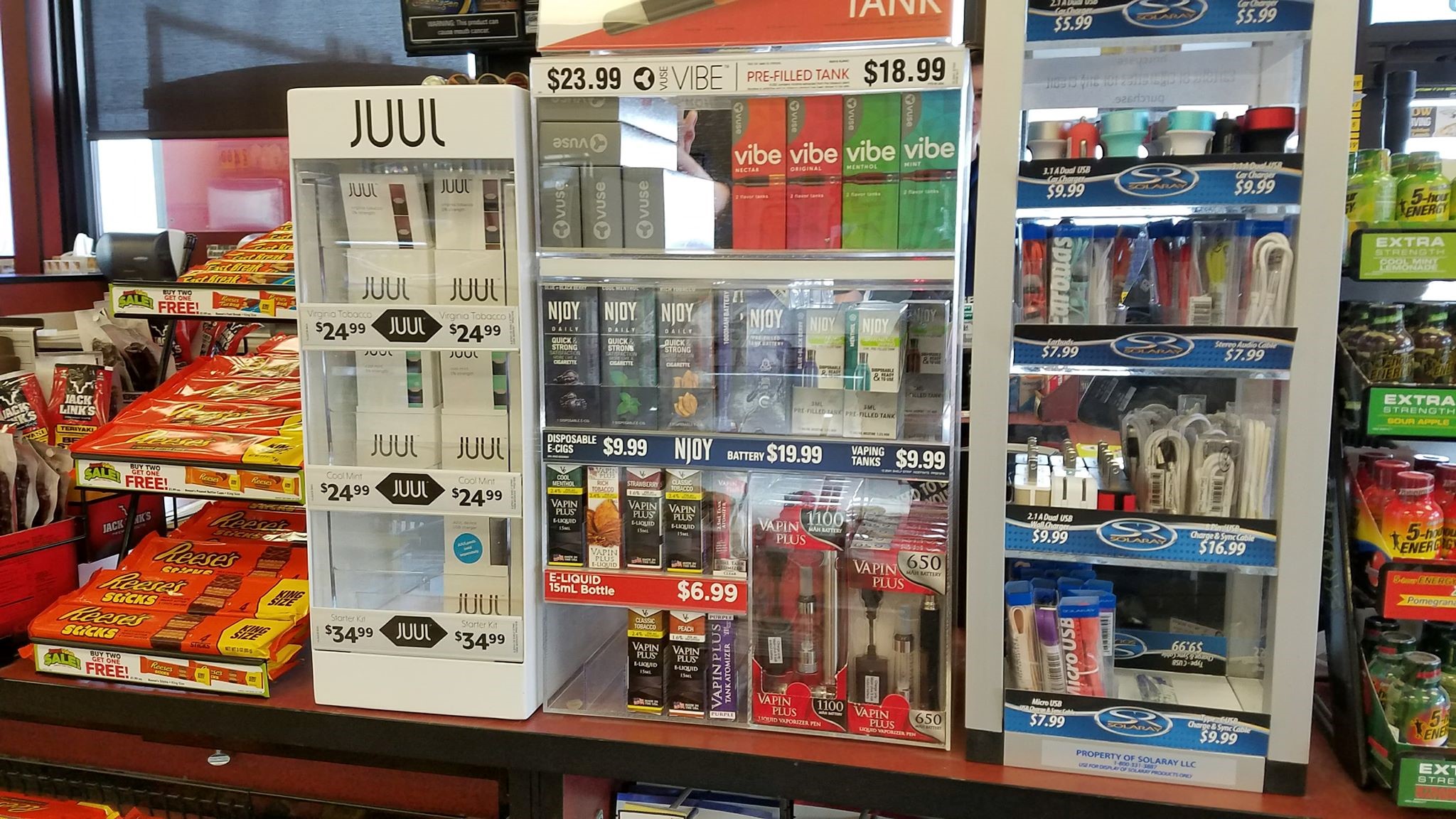Welcome to CounterTobacco.org’s “News and Research Roundup!” Each month we post a summary of the latest research, reports, and news stories on counteracting tobacco product sales and marketing at the point of sale (POS). Keeping up with what’s happening in the POS movement all across the country can help you choose policies and strategies that work best for your community. New research can help provide support for your work and evidence for the importance of the “War in the Store.” Have a story you don’t want us to miss? E-mail it to us!
New Research
- Trends in Cigarette Advertising, Price-Reducing Promotions, and Policy Compliance in New York State Licensed Tobacco Retailers, 2004 to 2015, American Journal of Health Promotion
- Between 2004 and 2015, the number of licensed tobacco retailers in New York State decreased by 22.9% (from 25,740 in 2004 to 19,855 in 2015). This decrease was seen uniformly across the state. The number of convenience stores/gas stations and specialty retailers increased, while the number of large grocery stores, small grocers, pharmacies, and mass merchandisers that sell tobacco decreased. The average number of tobacco advertisements present at tobacco retailers increased from 15 per store in 2004 to 21.2 per store in 2008, but then decreased to 13.7 per store by 2014. While fewer convenience stores had tobacco advertisements present, those that did had more of them. The presence of price promotions deceased from 45.2% of stores to 24.3% of stores in 2015. Policy compliance for displaying age-of-sale signs increased from 39.2% in 2004 to 92.3% in 2015. Compliance with restrictions on self-service displays for tobacco products was high, at greater than 97% across all year surveyed.
Tobacco Advertising
-

tobacco advertisements outside a retailer Association Between Receptivity to Tobacco Advertising and Progression to Tobacco Use in Youth and Young Adults in the PATH Study, JAMA Pediatrics
- Youth and young adults who had never used tobacco but who had greater receptivity to tobacco advertising were more likely to be susceptible to tobacco use or to have used tobacco one year later. Receptivity for tobacco advertisements was highest for e-cigarette advertisements. Even those who were only receptive to e-cigarettes advertisements, but not cigarettes advertisements, were more likely to have used a cigarette at follow-up than those not receptive to any tobacco product advertisements.
- News Story: Receptivity to e-cigarette ads among young adults in the US leads to cigarette smoking, Medical Xpress
- Perceived racial/ethnic discrimination, marketing, and substance use among young adults, Journal of Ethnicity in Substance Abuse
- This study examined the impact of perceived experiences of discrimination, exposure to alcohol and tobacco marketing, and receptivity to marijuana marketing on substance use. Discrimination and marketing exposure were both independently associated with substance use. The study also found an interaction effect, where individuals with high levels of exposure to tobacco marketing were also likely to report high past 30-day cigarette use regardless of the level of discrimination they reported facing, while those with low exposure to tobacco marketing were only at increased risk of reporting cigarette use when they faced higher levels of discrimination
Tobacco 21
- Impact of New York City’s 2014 Increased Minimum Legal Purchase Age on Youth Tobacco Use, American Journal of Public Health
- While the rate of adolescent tobacco use declined in New York City following implementation of the city’s 2014 policy raising the minimum legal purchase age for tobacco products to 21, the rate of decline in adolescent tobacco use was greater in 4 Florida cities that did not have a Tobacco 21 policy in place. However, New York City also already had many strong tobacco control policies in place (e.g. high excise taxes, a minimum price law with a price promotion ban, strong smokefree air laws, and a ban on flavored tobacco products), which may have had a greater effect on adolescent use rates than Tobacco 21. In addition, New York City has a very diverse market with many small independent retailers and many neighboring areas without as strong tobacco policies. Researchers suggest that greater enforcement and monitoring is necessary to achieve the full benefits of a Tobacco 21 policy.
- Maximizing the Impact of Tobacco 21 Laws Across the United States, American Journal of Public Health
- In order for policies raising the minimum legal sales age for tobacco products to 21 to be impactful, they must be adequately enforced. Best practices include having an articulated plan for enforcement with responsibility given to a single agency, ongoing compliance checks, funding for enforcement inspections, having high penalties (e.g. high fines, license suspension or revocation) for violators, and practicing merchant education. In addition, this paper suggests that as repeat violators have their license to sell tobacco revoked, a “cap and winnow” policy could be implemented that prevents them from being reissued, reducing tobacco retailer density and further reducing access to tobacco. The author makes a total of seven recommendations to strengthen enforcement and reduce illegal sales.
- Learn more about Tobacco 21 policies.
Policy Impact
- Potential Public Health Effects of Reducing Nicotine Levels in Cigarettes in the United States, New England Journal of Medicine
-
low cigarette prices A simulation model indicates that lowering the nicotine content of cigarettes to minimally addictive levels in the United States would decrease tobacco-related mortality significantly, both due to cessation rates and a reduced number of people who initiate smoking or become established smokers. The model estimates that a reduced nicotine product standard would prevent 2.8 million tobacco-related deaths by 2060 and 8.5 million by 2100.
-
- The health, poverty, and financial consequence of a cigarette price increase among 500 million male smokers in 13 middle income countries: compartmental model study, BMJ
- This study modeled the impact of increasing the market prices of cigarettes by 50% among men in 13 middle income countries in Latin America and Asia. While the study found that across two billion men, 450 million years of life could be saved by this policy change, greater gains would be seen amongst the poorest 20%, who would see gains of 6.7 times more life-years than men in the richest 20%, resulting from increases in cessation as well as avoided treatment costs and health expenditures. It would keep 8.8 million med out of the Word Bank’s definition of extreme poverty.
- News story: Making Cigarettes More Expensive Could Save 450 Million Years of Life, Study Says, Fortune
- The State of US Health, 1990-2016: Burden of Diseases, Injuries, and Risk Factors Among US States, JAMA
- Tobacco use was the leading risk factor for disability-adjusted life years (DALYs) in 33 states and on average across the country. However, there were large differences in the burden of disease across states.
E-Cigarettes
- The Association of Point-of-Sale E-cigarette Advertising with Socio-Demographic Characteristics of Neighborhoods, Journal of Primary Prevention
- The study examined e-cigarette advertising at the point of sale in Omaha, Nebraska. There were higher levels of e-cigarette advertising in areas with lower median household incomes, higher percentages of Hispanics, and higher percentages of young adults. However, when adjusting for covariates, only the relationship between lower median household income and POS e-cigarette advertising remained significant.
- Learn more about e-cigarettes at the point of sale.
- The Debate About Electronic Cigarettes: Harm Minimization or the Precautionary Principle, Annual Review of Public Health
- Research letter: On the popularity of the USB flash drive-shaped electronic cigarette Juul, Tobacco Control
Industry News
- U.S. Smokeless Tobacco Company Submits Modified Risk Tobacco Product Application to FDA, BusinessWire
- Cigarette prices likely to rise again next week, Winston-Salem Journal
- Reynolds brands gain ground on top-selling Marlboro; Juul reaches 54% market share, Winston-Salem Journal
- Vaping: A Growing Market for C-Stores, CSP Daily News
POS Policy in the Media
- FDA to re-examine premium cigars as it overhauls tobacco regulation, CNBC
- Initiative to Address Health Disparities Among Smokers, WUWF
- Chicago retailers told to post warnings about dangers of cigarette substitutes, Chicago Sun-Times
Tobacco Free Pharmacies
- Albany County Legislature Proposes a Ban on Pharmacy Tobacco Sales, WNYT
- Pharmacists back law to restrict tobacco sales, Times Union
- Tackling smoking in the black community – a step toward eliminating health disparities, The Hill
E-Cigarettes

- ‘I Can’t Stop’: Schools Struggle with Vaping Explosion, New York Times
- The Juul Is Too Cool, New York Times
- Vaping now an epidemic among US high schoolers, CNN
- Toxins produced by e-cigarettes vary by flavor, Penn State News
- Bedford Town Board Ponders Vape Shop Restriction, TAPinto.net
- Ads for E-Cigarettes Today Hearken Back to the Banned Tricks of Big Tobacco, Smithsonian
- Public health groups are challenging the FDA’s decision to delay e-cigarette regulation, CNBC
Menthol and Other Flavored Tobacco Products
- Worcester City Council backs restricting sales of flavored tobacco to adults only, Telegram
- The FDA is going after menthol cigarettes – and maybe even fruity e-cig flavors, CNBC
- Beverly Hills Poised to End Sale of Flavored Tobacco, Beverly Hills Courier
- Smokers Mount Fight Against Flavored Tobacco Ban in San Francisco, CBS SF Bay Area
- Editorial: Yes on Prop. E to uphold SF tobacco ban, San Francisco Chronicle
- Campaign to stop smoking includes focus on blacks targeted by menthols marketing, Spokesman-Review
Tobacco 21
- Chicopee raises minimum age to buy tobacco to 21, MassLive
- Rockland legislature votes to raise smoking age, Mid-Hudson News
- Gurnee raises age of tobacco to 21, Daily Herald
- North Mankato keeps T21 policy, won’t enforce until 2019, Mankato Free Press
- Minneapolis City Council to weigh raising the tobacco-buying age to 21, Star Tribune
- No Smoking in Bolingbrook Unless You Are 21, Patch
- Proposed legislation gains momentum, would raise legal age to buy tobacco in Connecticut, Fox 61
- Wilmette increases age for tobacco sales from 18 to 21, Chicago Tribune
- Basalt follows Aspen’s footsteps on buying cigarettes, tobacco tax in voters’ hands, Aspen Times
- Gainesville commissioners approve proposal to raise tobacco buying age limit, WCJB
- Aurora increases age to buy tobacco to 21, The Beacon-News
- Topeka Council to consider appeal of tobacco sales ordinance ruling, WIBW
- Burlington Set to Raise Tobacco Purchase Age to 21, Burlington Patch
- Akron Raises the Minimum Age to Buy Tobacco to 21, WKSU
Find more stories in last month’s News and Research Roundup.
Know of a story that we missed? Email us, and we’ll be sure to include it in next month’s roundup!


